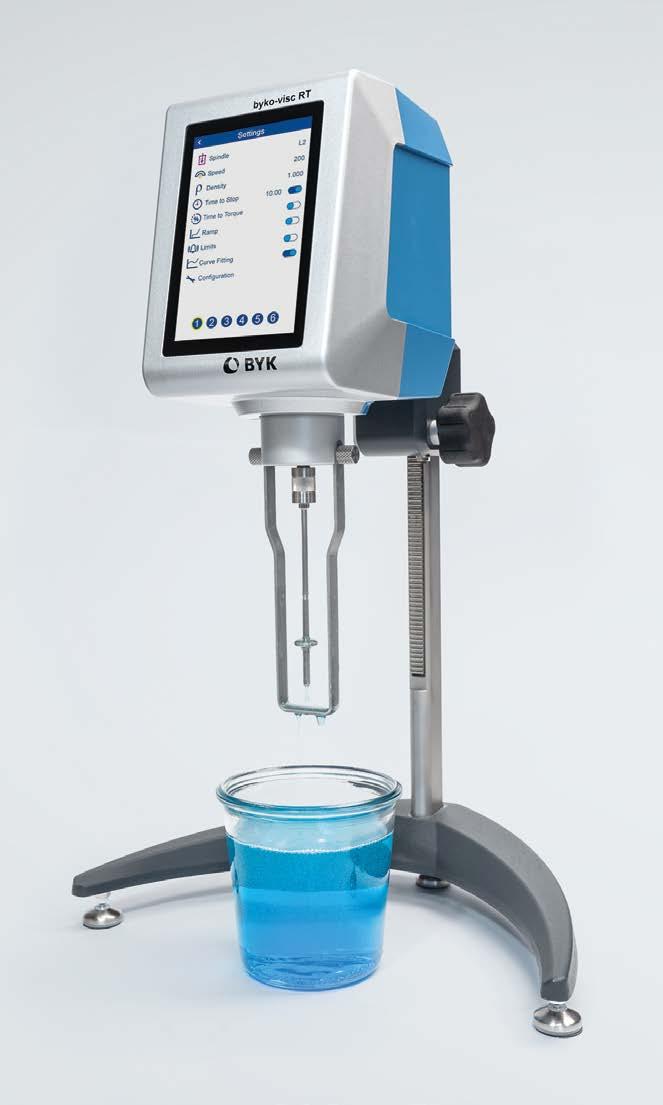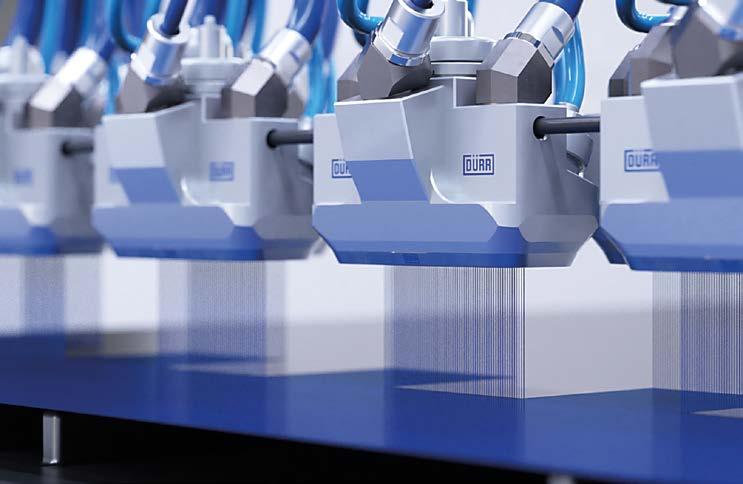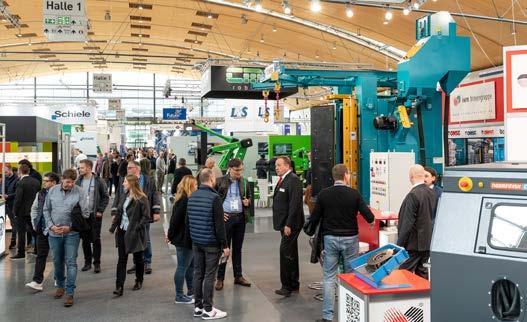
7 minute read
INNOVATIONS:PRESENT&FUTURE
In the AutoInspect demonstrator, the car body is transported to the inspection stations on a conveyor system. The picture shows the deflectometry portal: the software can detect surface defects based on the reflection of the striped patterns displayed on the monitors.
AutoInspect Takes the Quality of Industrial Inspection Processes to a New Level
Karlsruhe (Germany)
The quality of industrial production processes is ensured by a large number of sensor-based individual inspections. This generates large amounts of data. However, until now, the information from the individual sensors has generally only been looked at in isolation. The AutoInspect solution from the Fraunhofer Institute of Optronics, System Technologies and Image Exploitation IOSB over-comes this issue by linking all of the data to create a consolidated overview. Now, for the first time, linking the measured values is facilitating intelligent evaluation and the detection of hidden faults. This increases efficiency and ultimately improves product quality. A demonstrator has been presented at the Hannover Messe 2022 from May 30 to June 2 at the joint Fraunhofer booth.
Quality inspections are an integral aspect of industrial manufacturing. Sensors at various inspection stations measure the properties and quality characteristics of the test object. In automotive manufacturing, for example, this could be gap dimensions, the quality of the paintwork or the strength of certain parts, to name just a few examples. Over the course of the numerous inspections, some of which are sensor-based and some manual, a large amount of data and measured values are generated, providing accurate information about the characteristic measured in each case. But there is one problem: all these data are usually stored separately from each other. Recently, a team of researchers at the Fraunhofer Institute of Optronics, System Technologies and Image Exploitation IOSB developed AutoInspect, a solution that combines a wide variety of inspection modalities in a single system and links all the results. The researchers have brought together a wide range of sensors, interfaces and software to create an easily adaptable all-in-one solution. AutoInspect project manager Henning Schulte says: “The wealth of data generated at the sensor-based inspection points constitutes a valuable treasure trove of hidden information. By linking them, we are able to unearth this treasure.” AutoInspect provides a consolidated overview and enables intelligent evaluation of all relevant inspection data and measured values. In this way, previously unrecognized interrelationships in the manufacturing process suddenly become visible. This makes it easier to identify the causes of faults, which in turn makes the entire production process more efficient. Ultimately, this also improves the quality of the products.
Sensor data and location information
A highlight of AutoInspect is the ability to combine the inspection results with the respective location information: the first step is to create a 3D mesh of the test object based on existing CAD models of the product. However, this depiction in the software goes much further than a conventional 3D computer graphic of an object. This is because every measured value is stored with reference to this 3D mesh, i.e., with the precise location of the measurement position on the test object. This creates a digital twin that contains all relevant sensor data, including the associated location information, plus metainformation such as the batch number of the material used or the time of inspection. In this way, a consolidated overview of all inspection data is created, which, assuming the relevant inspection stations are in place, can cover the entire production process. From clamping the first piece of sheet metal, shaping the sheets and various bonding and welding processes right through to applying the paint. By linking the measured values in the AutoInspect software, it may now be possible to identify, for example, that a gap dimension is always too large at a certain point if a certain temperature limit value is exceeded during a previous machining step. The inspection team on the shop floor can then follow up on this tip, analyse the cause and ultimately fix the problem. This in turn is reflected in altered data and measured values in the 3D mesh. By taking this approach, inspection and production merge seamlessly into an optimized and highly efficient overall process. “In this way, we are helping industrial customers to gain a better understanding of what are often complex production quality issues and to get to grips with them more quickly by enabling them to intelligently analyse all of the linked inspection data throughout the entire process,” Schulte summarizes. The requirement here is that the Autoinspect software, which collects all of the sensor data and enables evaluation with graphical tools, is configured correctly.
Standard interfaces for sensors
The team at Fraunhofer IOSB developed and tested the technology with sensors for a 3D scan as well as deflectometry and ellipsometry. Ellipsometry, for example, is able to determine the thickness of a surface coating by registering the polarization state of reflected light. Deflectometry measures and inspects the shape of specular or

© Fraunhofer

In the AutoInspect demonstrator, the car body is transported to the inspection stations on a conveyor system. The picture shows the deflectometry portal: the software can detect surface defects based on the reflection of the striped patterns displayed on the monitors.
high-gloss surfaces such as painted sheet metal. These measurement techniques and the further development thereof have been a separate object of research at Fraunhofer IOSB for years now. However, the Fraunhofer solution is not tied to specific sensors, relying instead on the open OPC UA (OPC Unified Architecture) interface. “Any sensor or measuring device that is compatible with OPC UA can be easily integrated into AutoInspect via plug and play,” says Schulte. Moreover, it is possible for a worker to carry out manual inspections assisted by augmented reality.
Ideal for inspections on machines and vehicles
Evaluation of the measurement results is not limited to the current production process or the one just completed. The history of the inspection results within AutoInspect can be analysed beyond the current batch or manufacturing process. This makes it possible to observe the product life cycle of machines or vehicles across maintenance and inspection intervals. For example, measurement data from previous inspections could be taken into account when inspecting the chassis and wheel tires on an ICE train in order to better understand the latest measured values. Particularly when inspecting safety-relevant components, the ability to consider all of the maintenance cycles, including all of the data in AutoInspect, means that the causes of defects can be traced more quickly. Ideally, problems can even be detected in advance using AI-based data analysis and the safety of the respective machine or plant can be quickly restored.









SPECIAL ISSUE ON ARCHITECTURE & DESIGN
30 HIGHLIGHT OF THE MONTH Salchi Metalcoat Launches a New
Customer Oriented Business Unit
34 FOCUS ON TECHNOLOGY Kromoss’ Path to Sustainability: Elimination of
Hexavalent Chromium from the Pre-Treatment of Aluminium Bars and Sheets
40 FOCUS ON TECHNOLOGY Emotive Finishes on Bioclimatic Pergolas
to Experience New Outdoor Spaces in Contact with Nature: The Path of AMA Industries
48 HIGHLIGHT OF THE MONTH From a Family-Owned Business to an International
Supplier of Pre-Treatment Products: Cooperation and Partnerships as Corporate Pillars
52 FOCUS ON TECHNOLOGY AluCoating Chose Catalytic IR Technology to
Speed up Powder Coating on Aluminium Coils
58 HIGHLIGHT OF THE MONTH The COOL POWDER Coatings will be Displayed
at the Next Fuorisalone 2022
62 FOCUS ON TECHNOLOGY With its New Powder Application System, Anoxidall has
Achieved Greater Transfer Efficiency, Faster Cycle Times, and 15% Lower Powder Consumption in the Aluminium Profile Coating Sector
70 INNOVATIONS:PRESENT&FUTURE Fluoride Removal with FLUORIDITE
74 INNOVATIONS:PRESENT&FUTURE Axalta Coating Systems Introduces a New Series of
Anticorrosion Solutions for Every Possible Requirement
80 FOCUS ON TECHNOLOGY Its Paint Supplier’s Quick and Timely Service
Sped up the Delivery Time of Alusteel Coating’s Perfectly Pre-Painted, Customised Coils
86 FOCUS ON TECHNOLOGY How to Comply with the National Water Discharge
Regulations: The Success Story of the Bulgarian Company VIAS Ltd.
92 INNOVATIONS:PRESENT&FUTURE MICROFREE®: the New Series of Powder Coatings with Antibacterial and Antiviral properties
94 FOCUS ON TECHNOLOGY A Two-Step Transition From Chromate Treatment
to a Chromium-Free Cycle on an Aluminium Coil Coating Line
100 FOCUS ON TECHNOLOGY The First CUBE Plus Installation in the USA:










